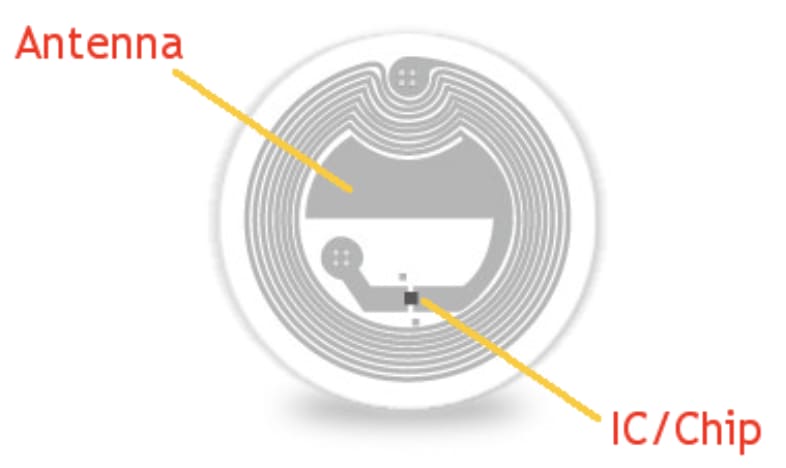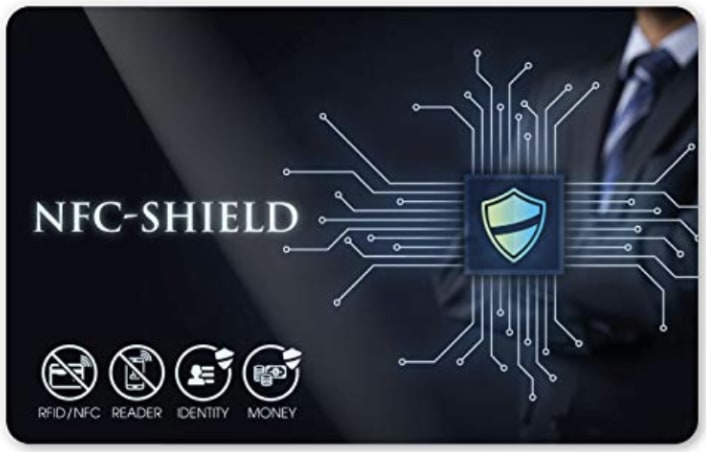If you use many NFC or RFID cards in your everyday life, you might sometimes notice that they don’t function properly, and if you keep them all in your wallet, as most people do, you might wonder whether they are somehow interfering with each other. Is this even possible? When these cards are near each other, does this hinder them from being able to swipe into your office, or use contactless payment? The short answer is — yes! This can actually happen, and in practice often does. In this article, we’ll explore the causes of this issue, and offer ways to address it, and make sure that it doesn’t cause you a headache every time you reach for your wallet.
What causes the interference?
In this section, we’ll discuss what causes the NFC/RFID interference, and why it might happen in your wallet.
NFC/RFID Technology Overview
We’ve already covered NFC and RFID tech extensively in another article, so this will only be a short summary. Basically, NFC and RFID technologies rely on radio waves to transmit information — RFID actually stands for radio frequency identification. NFC is just a subset of RFID, with more strict rules and standards applied to it, making it more secure and making the transmission of information faster.
They exist concurrently with Bluetooth technology, with some major differences. First off, NFC only works at very close distances, whereas Bluetooth can work up to about 100 feet apart, depending on the strength of the device. Also, more importantly, NFC allows for one of the communicating devices to not need a power supply. This is the distinction between active and passive devices.
Active vs. Passive Devices
As mentioned, one of the main advantages of NFC technology is that one of the two communicating chips doesn’t need to have a power supply. This is the passive device of the pair, and it can actually draw power from the active device using electromagnetic induction.

What happens here is that thanks to the proximity requirement of NFC, the active device can use magnetism to generate electricity inside the passive device’s coils (the ‘antenna’ in the above image), which will power up the NFC chip, and allow it to communicate with the active device.
In practice, this manifests itself as NFC cards and readers. Readers are the active devices, given that there is no issue with them having a permanent power supply, but NFC cards don’t have one, and don’t even have the capability to have one — how would you plug it in, and where would it store power? A separate power source would make it too bulky to fit in a wallet or badge holder. As a result, NFC cards have passive chips, and rely on proximity to readers to induce a current in them, which prompts them to transmit their ID information.
“Crossed Wires,” Except with Wireless Tech
While the distinction between active and passive devices discussed above is surely an amazing innovation and allows for a much wider expansion of NFC standards, the one downside to it is that it often results in NFC interference, when you have multiple NFC cards in close proximity to each other.
This happens because when you approach a wallet or badge holder with multiple NFC cards to an NFC reader, and they all enter into the electromagnetic induction range, the reader will activate them all, irrespective of whether it’s the “right” card or not. This means that they will all begin transmitting their NFC identification information.

A direct result of this is that the active NFC device, the reader, will receive a bunch of NFC ID signals, but it won’t actually know which is the “correct” one. If it happens to receive another one before the intended one, it will think that the first (incorrect) signal was the intended one, and naturally, the signal will not be authenticated.
To ground this in a real example, say you have a contactless NFC bank card and an NFC access card side by side in your wallet. You tap the wallet to the reader at your office, and the bank card’s signal reaches the reader first. The reader thinks that the bank card was the intended access card signal, and naturally will not allow you to enter the building.
Learn more about NFC readers and access control
Download our physical security guide.
How can I address it?
In this section, we’ll explore how, much to everyone’s chagrin, there is no “silver bullet” here to solve the issue of NFC interference. There are, however, some strategies you can employ to make sure that you minimize the rate at which this occurs.
Separate Your NFC/RFID Cards
The first, obvious solution would be to separate your cards. NFC range usually maxes out at around 10cm (around 3 inches), meaning that if your cards are separated by more than that amount there is no risk of interference. You could accomplish this by having one card in your wallet, and another in a badge holder, and keeping them separated by around 2-3 inches when tapping one to a reader.
Even closer than 10cm would be fine, though. In practice, having cards on opposite ‘sides’ of your wallet, and only tapping the proper side of the wallet to the NFC reader, is usually enough. However, this might have more to do with other objects blocking the signal, which brings us to our next method for minimizing interference — putting stuff between your NFC cards.
The Old-Fashioned Method — Aluminum Foil or Enough Other Stuff
Metal absorbs magnetism, that’s essentially what the idea is here. Yes, you’d be correct to point out that it conducts electricity, but that means that it conducts it through the material itself, and essentially stops it if it were going through the air and about to hit it. In this context, if you put the right metal, or enough other metal, between your two NFC cards, even if they are both within range, the metal ‘barrier’ will work as an RFID card separator and absorb the signal of the card farthest away from the reader and will not trigger the wrong NFC chip.
This is why keeping your NFC cards on “opposite” sides of the wallet sometimes does the trick — many credit cards or transit cards, even if they’re not NFC based, have some sort of metal chip or magnetic strip on them, and this absorbs the signal. However, the most common ‘bootstrap’ method, so to speak, to eliminate NFC interference, is to keep a sheet of tin foil sandwiched between your NFC tags. This will totally block the magnetic signal, so all you have to do is present the correct NFC card to the reader (on the correct side of the wallet/badge holder), and you’re all set.
The Modern Method — Signal Absorbing Cards
There are, naturally, more modern and sophisticated ways to block NFC signals than a sheet of tin foil. There are specific cards or chips that you can put in your wallet that act as a piece of tinfoil would. Some are merely fancier looking cards that have aluminum foil lining, and thus block the signal while looking prettier. Others are more tech-enabled.

The card pictured above is one such card. This card, and similar cards, are still passive devices meaning that they don’t have to be charged, and don’t constantly emit an NFC signal. However, they instead have a chip that can still be activated by RFID signals, and when activated transmits a strong signal that drowns out/scrambles any other NFC/RFID signals in its vicinity.
This means that if you want to use those to block NFC signals, when you actually want to unlock a door, or pay with a bank card, you’ll have to take your relevant card out of your wallet and present it separately to the reader. Obviously, this is a hassle — the primary purpose of these cards is simply for protection against piracy or theft. You might have heard of devices that can steal NFC/RFID data. Modern NFC cards are well encrypted, but still susceptible, so devices of this nature make it so that thieves can’t read your cards’ NFC information.
Of course, another method for accomplishing this is sandwiching your NFC cards inside aluminum foil!
Main Takeaways
RFID interference is certainly an issue, especially with the proliferation of NFC cards on the market today, and all the use cases that they cover. Unfortunately, there’s no magic solution just yet, but with some clever little tricks you can make sure that the issue’s scope is minimized for you.
Save time. Enhance security.
Modernize your access control with remote management and useful integrations.
Continue learning

